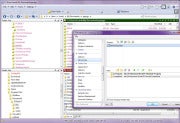Directory Opus has a well-deserved reputation as one of the most powerful Windows file managers, and version 10.0 keeps its old functionality while piling on even more. It's unlikely any user will need every function, tool, option, and setting available--but if you do need something, it's probably there. Directory Opus comes in a 32-bit and a 64-bit edition ($85 AUD, 60-day free trial)
 File explorer Directory Opus give you multiple windows, multiple tabs, and endless options.First, the basics: Directory Opus displays your files in "Listers", which most of us would just call "windows". Each lister can be configured in a variety of ways--single or dual display, file viewer or no, folder tree or no--and these settings can be altered at will. You can save favored combinations of settings and instantly set a lister to that format or style. You can have as many listers open at one time as you wish (within reason; if you try to open thousands, you'll probably hit memory limits), but my experience has been that I rarely need more than one or two, because each lister supports multiple tabs. My default lister with Directory Opus has two displays, two folder trees, and multiple tabs in each display. You can sort listings on more than one column (by modified date and then by name, for example), and version 10 adds in grouping--you can group files by any column, in addition to sorting (Sorting takes place within groups). Groups can be collapsed, making it easy to navigate large directories.
File explorer Directory Opus give you multiple windows, multiple tabs, and endless options.First, the basics: Directory Opus displays your files in "Listers", which most of us would just call "windows". Each lister can be configured in a variety of ways--single or dual display, file viewer or no, folder tree or no--and these settings can be altered at will. You can save favored combinations of settings and instantly set a lister to that format or style. You can have as many listers open at one time as you wish (within reason; if you try to open thousands, you'll probably hit memory limits), but my experience has been that I rarely need more than one or two, because each lister supports multiple tabs. My default lister with Directory Opus has two displays, two folder trees, and multiple tabs in each display. You can sort listings on more than one column (by modified date and then by name, for example), and version 10 adds in grouping--you can group files by any column, in addition to sorting (Sorting takes place within groups). Groups can be collapsed, making it easy to navigate large directories.
New in this version of Directory Opus is the metadata panel. Many file types, such as WMV, contain extensive properties which can record genre, artist, year of production, and so on. This information is often not displayed or is difficult to find and edit. Directory Opus allows you to easily view and change metadata, including standard Windows file properties, such as if the file is compressed or the creation and modification dates.
Also new is expanded support for file compression formats. Directory Opus 9 had built-in ZIP support; Directory Opus 10 extends this to RAR, 7ZIP, and several other formats, easily accessed from a right-click menu option (or a toolbar menu, or the menu bar). This feature provides several options for file extraction (such as selecting a group of archive files and extracting them each to a new folder) and compression.
The only real drawback to Directory Opus is that there is a lot of it, and there's usually more than one way to do something. Getting full value out of the program, as compared to just using Windows File Explorer, requires some effort on the part of the user, both to learn the functions and configure them. Tab Sets, for example, allow you to save and restore groups of tabs, but finding this feature takes a little digging, as does specifying the tabs you wish to use. After using Directory Opus for over a year, I still haven't dived into the command line functionality, which is extensive.
Directory Opus is not cheap at 85 Australian dollars, but it's not overpriced, given the range of functionality--if you take advantage of it. The sixty-day trial is more than adequate to test the full range of options, tools, and features. I strongly recommend downloading it.
Source: http://feeds.pcworld.com/click.phdo?i=f0cbc1d8c334d47b23f9fe560a31666f
gypsies rockefeller center kyoto sasquatch big foot plantar fasciitis queen latifah
No comments:
Post a Comment
Note: Only a member of this blog may post a comment.